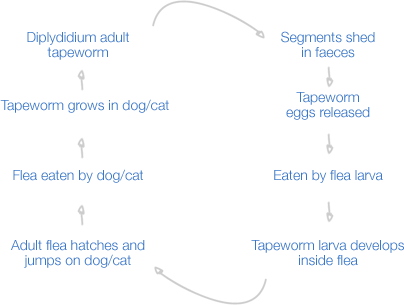These are complex animal parasites that have a life cycle requiring at least two ‘hosts’ to survive. The primary or intermediate host carries the ‘larval’ form, often living in the most inner most tissues of this host. In most cases, this primary host is eaten by the secondary or final host, with the tapeworm developing to an adult in the intestine of this last host. Because dogs are carnivores and by nature are creatures that will tend to eat others, they are invariably the final host. Many tapeworms are species specific; i.e. they will form an adult in a specific species (perhaps the dog and not the cat).
The principal species affecting cats and dogs in northern Europe can be divided into three groups.
This is the most common tapeworm of cats and dogs. The adult lives in the small intestines of the cat or dog and sheds segments which are usually 5-8mm long (this is the width of the parasite when the segment is attached to the adult) when passed out in the faeces. The segments are often shed inside your home where the eggs are released. These are eaten by flea larvae which crawl around in the pile of the carpet and cracks and crannies in flooring and skirting boards. The flea larvae act as the intermediate host and will develop into an adult flea in due course. When the flea jumps onto your dog and sucks blood sometimes, it can be eaten by the dog and allow the larval stage to complete its development into an adult worm. The life cycle of Dipylidium is only three weeks.

The key to success in eradicating this Dipylidium from your pet is to understand the life cycle and to understand that you have to eliminate the flea to eliminate the worm.
There are a large number of Taenia species, of which a few affect dogs and cats. They have different intermediate and final hosts in many cases, and it depends totally on your dog’s life style whether he or she will contact these worms. If you have a sedentary house pet, then it is unlikely, if you have an outdoor rabbiter, then it is quite likely. The life cycle varies depending on the species of Taenia from two to ten weeks. The segments vary in size depending on species but are often a cm in length.
| Name of Tapeworm | Final host | Intermediate host |
|---|---|---|
| Taenia ovis | Dog | Sheep |
| Taenia multiceps | Dog | Sheep |
| Taenia serialis | Dog | Rabbit |
| Taenia hydatigena | Dog | Sheep/Ox/Pig |
| Taenia pisiformis | Dog/Cat | Rabbit |
| Taenia taeniaeformis | Cat | Mouse/Rat |
This group are a threat to human health; i.e. they are a zoonosis. For this reason, owners of cats and dogs should be aware of them and should worm regularly as humans can act as the intermediate host for this group. They are particularly prevalent in sheep rearing areas where dogs may have access to infected dead sheep carcases. If you live in a rural area, we would recommend very regular worming against this parasite. They have a life cycle of between four and six weeks and are so small in their adult form in the dog that you are unlikely to spot them. If your pets eat carrion, hunt or receive raw meat you should de-worm them regularly. The final host can be almost any type of dog, cat and wild canid and the intermediate host is man, herbivores (sheep, ox, deer), pig and man. In the intermediate host Echinococcus forms hydatid cysts, often in the liver and lungs. This can lead to organ failure and death. In Great Britain the problem is restricted and caused by Echinococcus Granulosa. Elsewhere in Northern Europe the problem is more widespread and caused by another species, Echinococcus Multiocularis which is a very serious zooanosis in man.
Most tapeworms live in the small intestine of the final host, the dog. Heavy infestations in this area may cause diarrhoea, occasionally vomiting when large sections may be vomited, unthriftiness and weight loss. More commonly low infestations will cause anal irritation with the dog licking and chewing around the anal area or scooting (dragging hind quarters along the ground). This is due to expulsion of the worm segments which due to their sticky nature often attach to the skin and hair around the anal region. When they first emerge they have a pearlescent white colour and contract along their length looking at times like a miniature dumb-bell. The contractions of the segment are highly irritating to the dog. After a while they dry and shrivel. A lot of people compare them with a grain of rice which changes from white to yellow with time.
There are several broad spectrum products on the market.
This again depends on the dog’s lifestyle and where you live. A rural, dog in sheep country may need to be wormed every month. We would recommend twice yearly worming as a minimum with worming every three months in any pet which regularly hunts or scavenges.
We would like to introduce you to the Pet Health Club from Isabelle Vets that aims to bring you peace of mind by covering nearly all of the routine costs and procedures that are not covered by pet insurance.